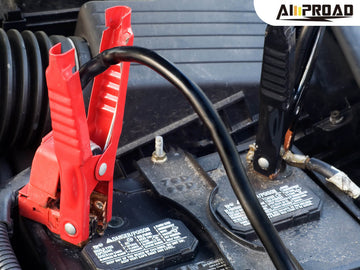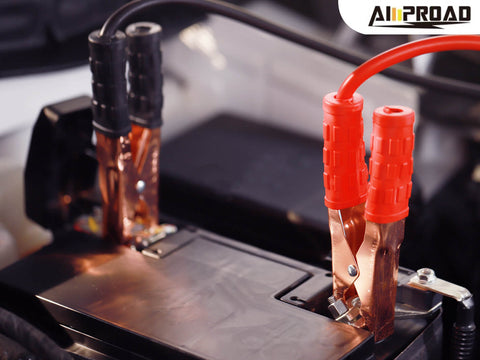
Jump starters and jumper cables serve the common purpose of reviving a dead car battery, albeit through different means. Jump starters are portable battery packs equipped with clamps to jump-start a vehicle without the need for another vehicle's battery. They offer convenience and independence, especially in remote locations or when assistance isn't readily available. On the other hand, jumper cables require a donor vehicle with a charged battery to jump-start the dead battery. While jumper cables may seem less convenient, they are widely available and don't require additional equipment. Ultimately, the choice between jump starters and jumper cables depends on factors such as portability, accessibility, and personal preference. Both methods effectively accomplish the task of jump-starting a vehicle, making them valuable tools for motorists facing battery-related emergencies.
Convenience & Ease of Use
Jump Starters - User-Friendly Power Packs
Jump starters emerge as a user-friendly solution for reviving dead car batteries, offering a convenient one-person operation. With most jump starters, all it takes is connecting the clamps to the battery terminals and initiating the jump-start process, eliminating the need for a second vehicle and another person's assistance. Their compact size and portability further enhance convenience, allowing drivers to carry them easily in their vehicles for emergencies. Additionally, many jump starters come with built-in safety features such as reverse polarity protection, preventing damage caused by incorrect connections. Overall, jump starters provide a hassle-free approach to jump-starting a vehicle, making them a popular choice for motorists seeking simplicity and autonomy.
Jumper Cables-The Traditional Solution with Potential Pitfalls
Jumper cables, while a traditional method for jump-starting a vehicle, present certain challenges that may detract from their convenience. Firstly, using jumper cables requires access to a second vehicle with a charged battery, which may not always be readily available, especially in remote areas. Furthermore, the setup process with jumper cables can be cumbersome and potentially awkward, involving positioning the vehicles close enough for the cables to reach both batteries. Moreover, there is a risk of user error in connecting jumper cables incorrectly, which could lead to electrical damage or even injury. Despite their ubiquity and simplicity in concept, jumper cables may pose logistical and safety concerns for drivers, particularly those lacking experience or confidence in their use.
In the battle between jump starters and jumper cables for convenience and ease of use, jump starters emerge as the frontrunner, offering a straightforward and independent solution for jump-starting a vehicle. Their user-friendly nature and portability make them a practical choice for motorists seeking a hassle-free approach to battery-related emergencies. However, while jumper cables may lack the inherent simplicity of jump starters, they remain a viable option for drivers with access to a second vehicle and the confidence to navigate the setup process safely. Ultimately, the winner of this round depends on individual preferences and circumstances.
Power & Performance

Jump Starters - Versatile Power Packs
Jump starters exhibit varying power capabilities tailored to accommodate different engine sizes, making them versatile tools for jump-starting vehicles of various types. These power packs typically come in different models with varying peak current ratings, allowing drivers to select one suitable for their specific vehicle. While many jump starters can effectively handle small to mid-sized engines, it's essential to consider potential limitations when dealing with larger engines that require more cranking power. In such cases, selecting a jump starter with a higher peak current rating becomes crucial to ensure sufficient power delivery for a successful jump-start. Despite this consideration, jump starters remain a reliable choice for providing the necessary power to revive a dead car battery, offering peace of mind to drivers facing battery-related emergencies.
Jumper Cables - Full Power Transfer
Jumper cables boast the ability to transfer the full power of a healthy car battery to the dead battery, provided the cables themselves are of sufficient gauge and quality. This direct transfer of power allows for a robust jump-start, leveraging the full potential of the donor car's battery to kick-start the vehicle with the dead battery. However, it's essential to note that the effectiveness of jumper cables depends heavily on the health and capacity of the donor car's battery. If the donor car's battery is weak or depleted, jumper cables may not provide the necessary power to jump-start the vehicle, resulting in an unsuccessful attempt. Additionally, jumper cables may not be as effective for jump-starting vehicles with significantly larger engines, as the donor car's battery may struggle to provide enough cranking power to start the engine.
In the showdown between battery boosters and jumper cables for power and performance, both options offer distinct advantages and considerations. Jump starters provide versatility and reliability in delivering the necessary power to jump-start vehicles of varying engine sizes, while jumper cables offer the full power transfer capability of a healthy car battery. Ultimately, the effectiveness of each method depends on factors such as the size and condition of the vehicle's battery, making it essential for drivers to assess their specific needs and choose the most suitable option accordingly.
Additional Features & Safety
Jump Starters - Feature-Packed Emergency Tools
Jump starters stand out for their array of additional features designed to enhance functionality and safety during emergencies. Many booster batterie models come equipped with built-in LED flashlights, providing illumination in dimly lit conditions to facilitate battery connections or other roadside tasks. Moreover, some jump starters feature USB ports, allowing users to charge their electronic devices such as smartphones or tablets directly from the power pack, providing added convenience during roadside emergencies. Additionally, certain advanced models may include emergency air compressors, enabling drivers to inflate flat tires and address other minor roadside maintenance tasks.
Furthermore, safety is paramount with jump starters, as most models incorporate built-in safety features to protect both the user and the vehicle. Common safety features include spark protection, which prevents sparks or arcs during battery connection, reducing the risk of accidental ignition. Additionally, reverse polarity protection safeguards against incorrect cable connections, ensuring that the battery booster operates safely and effectively. These built-in safety features provide peace of mind to users, allowing them to jump-start their vehicles confidently without worrying about potential hazards.
Jumper Cables - Basic but Essential Tools
In contrast, jumper cables offer a straightforward solution for jump-starting vehicles but lack the additional functionalities found in jump starters. Jumper cables serve a singular purpose: transferring power from a healthy car battery to a dead battery to initiate the vehicle's engine start. While they may not offer the convenience of built-in flashlights or USB ports, jumper cables remain indispensable tools for roadside emergencies.
However, using jumper cables safely requires proper cable placement and user knowledge to avoid potential safety hazards. Incorrect cable connections or placement can lead to electrical damage, sparks, or even injury. It's essential for users to familiarize themselves with the correct procedure for using jumper cables and to exercise caution during the jump-start process.
In the showdown between jump starters and jumper cables for additional features and safety, jump starters emerge as the more versatile option, offering a range of useful functionalities and built-in safety features. While jumper cables serve as essential tools for jump start vehicles, they lack the additional features and safety measures inherent in jump starters. Ultimately, the choice between the two depends on individual preferences and needs during roadside emergencies.
Cost & Long-Term Value

Jump Starters - Initial Investment for Versatility
Jump starters typically come with a higher upfront cost compared to jumper cables due to their added functionalities and built-in features. Depending on the model and brand, jump starters may range in price from moderate to higher-end options. However, it's important to consider that the initial investment in a jump starter may provide long-term value beyond just jump-starting a vehicle. Many car booster pack models offer multi-purpose functionality, such as charging electronic devices via USB ports or providing emergency air compression for tire inflation. This versatility can increase the overall value proposition of a jump starter, making it a valuable addition to a driver's emergency toolkit.
Jumper Cables - Affordable One-Time Purchase
In contrast, jumper cables offer a more budget-friendly option for jump-starting vehicles, typically at a lower upfront cost compared to jump starters. The simplicity of jumper cables contributes to their affordability, making them an accessible option for drivers seeking a basic solution for battery-related emergencies. However, it's important to note that jumper cables may offer lower long-term value compared to jump starters. Jumper cables serve a singular purpose - transferring power from a donor vehicle to a vehicle with a dead battery - and do not provide additional functionalities or built-in features. As a result, while jumper cables may be a cost-effective solution for immediate jump-starting needs, they may offer limited value in terms of versatility and long-term utility.
In the debate between jump starters and jumper cables for cost and long-term value, the choice ultimately depends on the individual's budget, preferences, and needs. Jump starters offer versatility and additional features but come with a higher upfront cost, while jumper cables provide a budget-friendly option for basic jump-starting needs. Considering factors such as functionality, convenience, and long-term utility can help drivers make an informed decision when selecting the most suitable option for their emergency preparedness toolkit.
Considering Your Needs
In evaluating the strengths and weaknesses of jump starters versus jumper cables, it's essential to weigh several factors to determine the best option for your needs.
Jump starters, including the AMPROAD portable jump starter, offer convenience and versatility, with built-in features like USB ports, emergency flashlights, and even air compressors in some models. They are user-friendly, often requiring only one person for operation, and come with safety features like spark protection and reverse polarity protection. Jump starters are recommended for those prioritizing convenience, safety features, and the potential for additional functionalities beyond jump-starting a vehicle. They are particularly valuable for drivers who may need a multi-purpose tool to address various roadside emergencies.
On the other hand, jumper cables provide a budget-friendly option for jump-starting vehicles, with a lower upfront cost compared to jump starters. While they lack the additional features and versatility of jump starters, jumper cables serve their primary function effectively - transferring power from a donor vehicle to a vehicle with a dead battery. They are recommended for budget-conscious drivers who have a reliable network of helpers and prioritize pure jump-starting functionality over additional features. Proper knowledge of how to boost a car, including cable placement and safety precautions, is crucial when using jumper cables to avoid potential hazards.
FAQs / People Also Ask
What are jump starters and jumper cables?
Jump starters are portable battery packs equipped with clamps to jump-start a vehicle without the need for another vehicle's battery. Jumper cables, on the other hand, are cables used to transfer power from a donor vehicle to a vehicle with a dead battery to initiate the engine start.
Are there any safety considerations to keep in mind when using jump starters or jumper cables?
Yes, safety is paramount when using either jump starters or jumper cables. Proper cable placement, following manufacturer instructions, and understanding how to boost a car safely are essential to avoid electrical hazards or damage to vehicles. Additionally, familiarity with safety features such as spark protection and reverse polarity protection in jump starters can help prevent accidents during the jump-start process.


